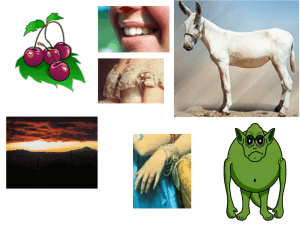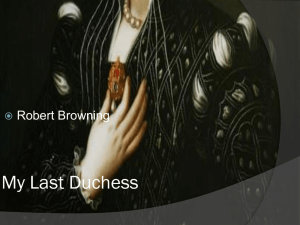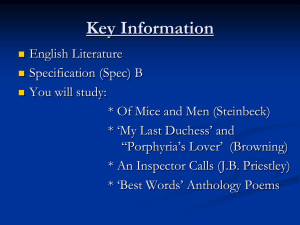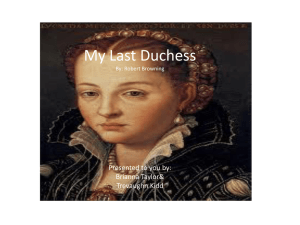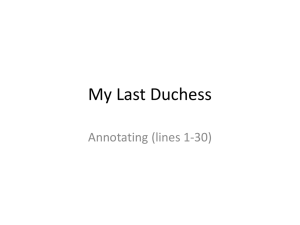MLD - Taylor High School
advertisement
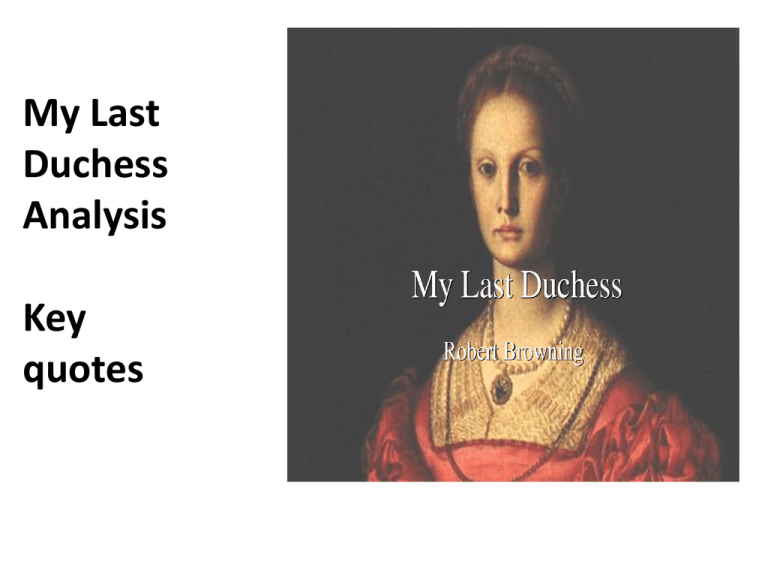
My Last Duchess Analysis Key quotes Themes in MLD •Power •"My Last Duchess" is all about power: the political and social power wielded by the speaker (the Duke) and his attempt to control the domestic sphere (his marriage) in the same way that he rules his lands. He rules with an iron fist. The Duke views everything that he possesses and everyone with whom he interacts as an opportunity to expand his power base. Wives need to be dominated; servants need to understand his authority; and fancy objects in his art gallery display his influence to the world – if he decides to show them. Kindness, joy, and emotion are all threats to his tyrannical power. •The Duke of Ferrara sets himself up to have his power threatened, because he never communicates directly with people about his expectations for their behaviour. Themes in MLD •Language and communication •In "My Last Duchess," choices about what to communicate and what to withhold are the means by which power is wielded. The Duke sees communicating openly and honestly with someone about the problems you have with their behaviour as impossible because it would compromise his authority. It’s also possible to hint at his power by intentionally letting stories of the past exploits slip to a new listener. However, because language is full of subtlety, the Duke might accidentally communicate more than he meant to about his own psychosis. Themes in MLD •Art and culture •"My Last Duchess" is a piece of art about a piece of (fictional) art – a poem about a pretend painting. The speaker of the poem, the Duke of Ferrara, is a connoisseur and collector of objets d’art, or art objects, which he displays privately in order to impress people. In this poem, art and culture become tools for demonstrating social status – and ways to reduce unstable elements, like the Duchess herself, to things that can be physically controlled. •Even though the Duke is a collector of art objects, he doesn’t really appreciate them; he only cares about the way they increase his status and demonstrate his power. Themes in MLD •Madness/Psychopathic tendencies •In "My Last Duchess," a husband murders his wife because she blushes and smiles at other people – even though theses blushes are out of her control and probably entirely innocent. This is pretty much the textbook definition of an abusive, controlling husband. The Duke doesn’t even want his wife to thank people for gifts, because it makes him jealous. But we think this goes beyond abuse into the realm of madness: after all, trying to control someone is abuse; thinking that because someone blushes she must be having an affair, and that the only remedy is murder is just insane. •The Duke’s obsession with totalitarian power, and his tendency to punish innocent or nearly innocent behaviour with the most extreme penalties, make it clear that he’s a psychopath. Themes in MLD •Jealousy •The Duke in "My Last Duchess" is pretty much the green-eyed monster incarnate. He’s almost an allegorical figure for jealousy. He’s jealous of the attention his wife shows to other people – even if all she does is thank them for bringing her some cherries. He’s jealous of every smile and every blush that she bestows, intentionally or unintentionally, on someone else. He’s so jealous that he can’t even bring himself to talk to her about her behaviour – murder is the only solution he can come up with. His jealousy isn’t just about romantic attention; it’s about any kind of attention. •The Duke is jealous of the way the Duchess treats other people, not because he loves her and wants all her love for himself, but because he wants her to acknowledge his power over her. Power (since none puts by The curtain I have drawn for you, but I) (9-10) The Duke’s first allusion to the great power he wields comes in a parenthetical aside, in which he lets slip, intentionally or unintentionally, that he alone controls access to his late wife’s portrait. Even her image is under his jealous guard. The words "control freak" come to mind. She thanked men, – good! but thanked Somehow – I know not how – as if she ranked My gift of a nine-hundred-years-old name With anybody’s gift. (31-34) The Duke’s emphasis on his family history and prestige – his "ninehundred-years-old name" – is underscored by his choice of the word "ranked" to describe the way people should react to gifts. – E’en then would be some stooping; and I choose Never to stoop. (42-43) Maintaining his own stiff-upper-lip dignity is more important to the Duke than dropping the Duchess a few hints that, if she doesn’t start being a bit less happy-go-lucky, he’s going to have her killed. "Stooping" would be a more serious threat to his power than her flirtatious nature. Language and communication never read Strangers like you that pictured countenance, The depth and passion of its earnest glance, But to myself they turned . . . And seemed as they would ask me, if they durst, How such a glance came there (6-9, 11-12) There are several different kinds of communication happening here. The Duke is telling a story about the portrait of the Duchess. But he’s also picking up on the nonverbal cues that tell him what question the listener wants to ask. The Duke also inadvertently implies that he’s used to people being afraid of him – they want to ask about the portrait, but they don’t dare. all and each Would draw from her alike the approving speech, Or blush, at least. (29-31) The Duke’s big problem with the Duchess is that the way she communicates with people isn’t nuanced enough. She gives the same friendly, flirty reaction to everyone and everything. Even had you skill In speech – (which I have not) – to make your will Quite clear to such an one (35-37) The Duke claims that he can’t talk to the Duchess about her behaviour because he’s not a good enough speaker to really make his feelings clear to her. But we can tell this is just an excuse, because the language he uses to describe the situation to the Count’s servant is quite skillful. Art and Culture I call That piece a wonder, now: Frà Pandolf’s hands Worked busily a day, and there she stands. (2-4) Notice that the first comment the Duke makes about his late wife’s portrait is that it is successful as a piece of art – it’s realistic, lifelike, and shows the painter’s skill. This artistic quality is far more important to him than any sentimental value. (We’re not sure the Duke has sentiment anyway.) that pictured countenance, The depth and passion of its earnest glance (7-8) The portrait of the Duchess seems to have captured her spirit. The Duke doesn’t describe the portrait in terms of its artistic school, colours, shapes, or brushstrokes – he describes its emotional quality. Madness THAT’S my last Duchess painted on the wall, Looking as if she were alive. (1-2) The Duke knows the difference between the living Duchess and her painting – but he doesn’t see it as much of a difference. It’s startling that he brings up the unusual circumstances of his previous wife’s death at the beginning of this conversation with the family he wants to marry into next. He’s a little bit obsessive to say the least. as if she ranked My gift of a nine-hundred-years-old name With anybody’s gift. Who’d stoop to blame This sort of trifling? (32-35) The Duke can’t believe that anyone would fail to understand that the most important thing in the universe is having an old family name. Again, this isn’t exactly insanity, but it is an extremely narrow-minded attitude toward values. "Just this Or that in you disgusts me; here you miss, Or there exceed the mark" (37-39) OK, at this point, we’re really starting to wonder about the Duke’s sanity. "Disgust" is a bizarrely strong and inappropriate word to use to describe your reaction to someone smiling when they ride their white mule. If the Duke is this inappropriate with his word choice, we have to wonder about the other ways in which he is inappropriate. Jealousy Sir, ’twas not Her husband’s presence only, called that spot Of joy into the Duchess’ cheek (13-15) The Duke is offended that the Duchess would take pleasure in anything other than him. Notice that the way she shows her pleasure is involuntary, (i.e., a blush counts as showing pleasure), but the Duke describes it as though it were a stain or taint, a "spot of joy." perhaps Frà Pandolf chanced to say, "Her mantle laps Over my lady’s wrist too much," or "Paint Must never hope to reproduce the faint Half-flush that dies along her throat" (15-19) The Duke’s jealous fantasies are very elaborate – he’s imagined in detail the kind of compliments that the painter might have paid to the Duchess, and the coy way that she might have responded. It’s important to remember that, as far as we know, this could all be in his head. There’s no evidence in the poem that the painter said these things or that the Duchess blushed in response. such stuff Was courtesy, she thought, and cause enough For calling up that spot of joy. (19-21) The Duke seems to believe that the Duchess chooses to blush or react to compliments and gifts. He describes her as "calling up" her blushes, instead of experiencing them as an involuntary reaction. As readers, we know that she probably isn’t blushing intentionally, and the Duke’s jealousy is illogical. Devices Example / further detail Conversational tone – the ‘Will’t please you…’ ‘Nay, language directs the listener we’ll go together down, sir.’ Disjointed thoughts – his sentences are frequently interrupted Urgent continuous pace Convoluted syntax (Convoluted means complex and difficult to follow. Syntax is the study of the rules for the formation of grammatical sentences in a language. ) Uses strategies of argument and persuasion So what? The speaker, The Duke, is talking to a visitor. It is meant to sound like one half of a conversation. ‘Somehow - I know not how – Some of these stops and starts ‘; (since none puts by the are responses to what the curtain…) listener has said, others are his own interruptions. In either case, he will carry on regardless! No verses. The poem moves The Duke will not be stopped. relentlessly on. He is in charge. Lines 35 - 43 He knows what he wants to say but is not fluent in expressing it – perhaps does not care. Rhetorical questions ‘Who’d stoop to blame…’ His whole purpose is to influence the listener. Regular rhyme and rhythm Ten beats to a line (iambic pentameter); rhyming couplets. Use of enjambment ‘Run-on lines’ – most lines are not end-stopped. ‘White mule’ to describe her horse; ‘officious fool’; Blunt language Repetition ‘thanked’; ‘spot of joy’ A dramatic monologue One person speaking and revealing a story Use of particular words is revealing (WC) "lessoned” "taming" Helps the poem along and gives structure to something which otherwise might seem rambling. This helps the sense of real speech. For all his power, the Duke is not well educated, or perhaps, does not care about expressing himself well. Again, as if real speech – no time to think of fresh ways of expressing things. The poem tells a story which consists of much more than the words spoken by the one giving the monologue. He expected to tame the Duchess as if she were a pet dog. Organise into co-op groups Academic LI: To understand how Browning uses poetic devices to effect in MLD Social LI: Coming to a consensus Allocate the following roles: • Group Manager • Resource Manager • Time Keeper/Noise Monitor • Reader/checker Group manager allocates poetic devices amongst group (2mins) Each person then tries to find as many examples of the allocated devices as possible (13 mins) Each person then presents their findings to the group (3mins) The group then brings their findings together and create a visualiser and present to the class (16 mins) Higher English Poetry Questions Hierarchy of Difficulty Two poem Question-Avoid if other options are available!! Theme –Examination of issue writer wishes to explore MOST and consideration of techniques employed to do so. DIFFICULT Technique -Analysis of Writer’s use of Poetic Techniques: Language/Symbolism/Structure/Line Layout/Rhythm/ Rhyme Scheme/ Contrast/Use of Persona Setting-Presentation of setting/Depiction of Values of a specific society/Relationship to Theme Single Character Presented- Emotional Impact upon Reader/Relationship to Theme Event/Situation-Opening/Climax of Poem Emotional Impact/Relationship to Theme EASIEST Answers to questions on poetry should address relevantly the central concern(s)/theme(s) of the text(s) and be supported by reference to appropriate poetic techniques such as: imagery, verse form, structure, mood, tone, sound, rhythm, rhyme, characterisation, contrast, setting, symbolism, word choice . . . 2014 Question 13 adapted. Choose a poem in which the poet creates a convincing persona. Show how the poet creates the persona, and discuss how this adds to your understanding of the poem as a whole.
